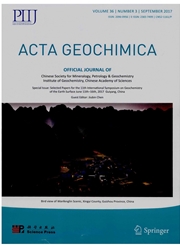

 中文摘要:
中文摘要:
原油的不同类型有组合的不同的轻烃和 geochemical 特征。从二种油基于轻烃数据,即,在中国的产生煤的油和海洋的油,在在 Tazhong 区域的海洋的油的轻烃相对通常从 Turpan 盆在 n-heptane,和产生煤的油被充实在甲基环己烷被充实。K 1 价值,由芒果树(1987 ) 报导了,在海洋的油的从 0.97 ~ 1.19 的范围,与什么基本上一致被芒果树以原油数据的多数在轻烃上报导。但是产生煤的油的 K 1 价值特别地高(1.35 1.66 ) 并且比那些远大海洋的油;heptane 在海洋的油珍视,从 32.3% ~ 45.4%,并且 isoheptane 从 1.9 ~ 3.7 珍视 ranging,比产生煤的油的那些分别地高,显示油在高成熟的舞台。另外,从 Turpan 盆的产生煤的油的逐出温度显然是比来自 Tazhong 区域的海洋的油的那些低的。
 英文摘要:
英文摘要:
Different types of crude oils have different light hydrocarbon compositional and geochemical characteristics. Based on the light hydrocarbon data from two kinds of oils, i.e., coal-generated oils and marine oils in China, light hydrocarbons in marine oils in the Tazhong area are generally relatively enriched in n-heptane, and coal-generated oils from the Turpan Basin are enriched in methylcyclohexane. The K1 values, reported by Mango (1987), range from 0.97 to 1.19 in marine oils, basically consistent with what was reported by Mango on light hydrocarbons in terms of the majority of the crude oil data. But the K1 values of coal-generated oils are particularly high (1.35-1.66) and far greater than those of marine oils; heptane values in marine oils, ranging from 32.3% to 45.4%, and isoheptane values, ranging from 1.9 to 3.7, are respectively higher than those of coal-generated oils, indicating that the oils are in the high-maturity stage. In addition, expulsion temperatures of coal-generated oils from the Turpan Basin are obviously lower than those of marine oils from the Tazhong area.
 同期刊论文项目
同期刊论文项目
 同项目期刊论文
同项目期刊论文
 An application of backflush and micro-flow techniques to the analysis of C5-C13 hydrocarbons in crud
An application of backflush and micro-flow techniques to the analysis of C5-C13 hydrocarbons in crud 期刊信息
期刊信息
